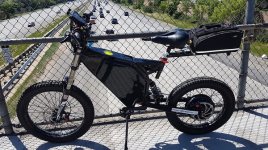Powervelocity.com
100 kW
Using Toshibas 3.6mOhms on this controller. With 24Fets, not so much heat is generated in the first place. But when it is, two row designs, thick heat spreader, and shell help.
There is also a fan under the seat post, so it can force the air through the frame box if it will ever become necessary. Hard to tell now with subzero temperature outside. I guess summer will tell.
There is also a fan under the seat post, so it can force the air through the frame box if it will ever become necessary. Hard to tell now with subzero temperature outside. I guess summer will tell.
fechter said:Hopefully you can fit the controller flat against a panel so it gets some heat dissipation. If the side panels are aluminum then almost anywhere would be good but obviously in front is better.



